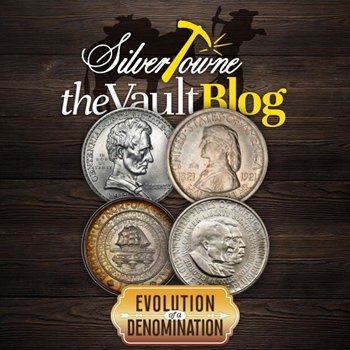
Despite the first half dollar commemorative from the United States being specially made for the World’s Columbian Exposition (1892-1893), the half dollar series would continue through the early 1950s. Nearly all the silver Classic Commemoratives were half dollars and many of them marked significant historical events. They were used to raise money for projects related to the historical events being commemorated, but by the 1920s, they started to be issued for unimportant events. They were also being struck at several different mints for several years to increase sales. Despite all this, classic commemoratives have become some of the most popular with collectors.
Illinois Centennial (1918)
Authorized to commemorate the 100th anniversary of Illinois being admitted into the Union, the 1918 Illinois Centennial Half Dollar Commemorative was designed by George T. Morgan (obverse) and J.R. Sinnock (reverse). The coin, commonly called the Lincoln half dollar, was the first souvenir piece for the event and was sold for $1 per coin. President Abraham Lincoln is featured on the obverse with the Illinois State Seal being the inspiration for the reverse. A little over 100,000 coins were struck.
Missouri Centennial (1921)
Like the 1918 Illinois Centennial, the Missouri Centennial was struck to commemorate the admission of Missouri to the Union. It was celebrated in Sedalia during August 1921. Depicting the bust of Daniel Boone on the obverse and a Native American on the reverse, the half dollar was designed by Robert Aitken.
The very first coins minted feature 2*4 incused on the obverse, showcasing that Missouri was the 24th star in the flag. This is known as the “Missouri 2 by 4.” However, another variety was struck without the 2*4 on the obverse known as the “Missouri plain.” According to PCGS, the idea behind having the 2*4 in the field on the obverse was to sell those coins for a premium to cover the cost of production. However, both varieties were sold for $1. While mintages between the two varieties can be debated, the 2025 Red Book records 9,400 were issued of the 2*4 while 11,400 were issued of the Plain.
Norfolk, Virginia, Bicentennial (1936)
To raise funds for the celebration of Norfolk’s anniversary of it growing from a township in 1682 to a royal borough in 1736, Congress first authorized a law for the striking of medals. However, advocates for the celebration were left unsatisfied by the medal, and finally were able to successfully change the authorization to half dollars. The new fifty-cent pieces were to commemorate the 300th anniversary of the original land grant and the 200th anniversary of the borough's creation.
The obverse of the 1936-dated silver half dollar features the Seal of the City of Norfolk with a three-masted ship as the centerpiece. The reverse depicts the Royal Mace of Norfolk, which was presented in 1753 by Lieutenant Governor Dinwiddie. Both the obverse and reverse were designed by William Marks Simpson and his wife Marjorie Emory Simpson. Nearly 17,000 coins were minted of the 1936 Norfolk Bicentennial Half Dollar Commemorative.
Carver/Washington Commemorative (1951-1954)
The Carver/Washington Commemorative was designed by Isaac Scott Hathaway and depicts the two prominent busts of Booker T. Washington and George Washington Carver.
Washington was an educator, lecturer, and principal of Tuskegee Institute, and was one of the leading figures in the charge of educating freed slaves. A freed slave himself, Washington pioneered efforts to ease a white America into acceptance of their fellow Americans. He helped to advance their independence and efficiency through training and education.
Carver was an agricultural chemist who worked on improving the economy of the South. He taught crop improvement with new uses for peanuts, sweet potatoes, soybeans, and cotton waste. His research helped several farmers in the south. In 1951, the George Washington Carver National Monument Foundation pushed for a commemorative that would honor Carver’s life. A bill was passed on September 21, 1951, that would authorize the mintage of up to nearly 3.5 million coins, largely derived from the remaining 1.5 million+ left over from the 1951 Booker T. Washington coins that would be melted down and struck as Washington-Carver commemoratives.
In 1951, the Carver/Washington half dollar commemorative was struck at Philadelphia, Denver, and San Francisco. They would all be struck at those prospective Mints for the next three years until 1954. The half dollar was struck to “oppose the spread of communism among Negroes in the interest of national defense.”
Source: NGC Coin; The Official 2025 Red Book; PCGS







